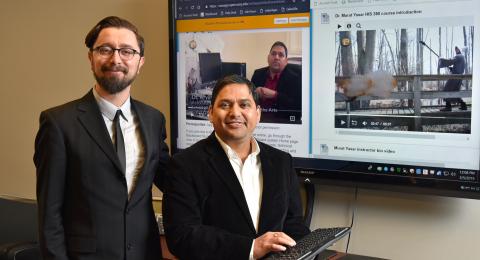Oswego's new emissaries for Open SUNY promote value of online courses
Office of Communications and Marketing
Published
SUNY Oswego professors Arvind Diddi and Murat Yasar have new standing to offer tips for successful online teaching: They recently began a year as Open SUNY Online Teaching Ambassadors.
Online courses benefit all kinds of nontraditional students -- career builders, job changers, completers of years-ago degrees, the military and other distance learners -- as well traditional "college-age" with work or family demands. Flexibility, accountability, consistent presence, and engaging content and assignments are among the ingredients for successful online courses, said the faculty members representing Open SUNY.
An innovative collaboration that opens the digital door to online-enabled teaching and learning opportunities across all 64 SUNY institutions, Open SUNY requires its teaching ambassadors to be "exemplary online educators, who are enthusiastic and effective in online teaching, and who can be positive and strong advocates for online teaching in our SUNY community."
Both history faculty member Yasar and Diddi, of the communication studies' journalism program, meet the Open SUNY requirement and then some, according to Theresa Gilliard-Cook, senior instructional designer for SUNY Oswego's Division of Extended Learning, who nominated them.
"We are so happy to have Arvind and Murat as ambassadors for Open SUNY and online teaching," Gilliard-Cook said. "It highlights the good work our faculty does and it highlights our instructional designers."
Dressing as Gandalf, the wizard in "Lord of the Rings," is not required, but having some fun also is highly recommended.
Yasar indeed dons Tolkien-inspired garb and sets out to "kill the demons of ignorance" for his introductory video for online courses. Diddi advocates for some familiarity and informality in online settings -- but also for firm, crystal-clear expectations in all interactions with students taking courses virtually.
Pioneering work
SUNY Oswego helped pioneer online learning in the 1990s through its work with the SUNY Learning Network. The college now offers, at least annually, scores of courses online -- graduate and undergraduate, spring and fall semesters, summer and an online-only winter session -- including all-online options for MBA and strategic communication graduate degrees. Many courses are available across the State University system for any student who wants to register; currently Open SUNY lists 478 offered by institutions around the state.
Diddi launched the online portion of his teaching resume by working with former Oswego instructional designer Kristen Flint in 2014 to redevelop "History of American Journalism" for distance learning. He and Flint followed up with Diddi's "Introduction to Newswriting and Reporting" and "Research Methods for Mass Media."
"The strength of online is in its flexibility," Diddi said. "But it needs to have flexibility with accountability, for yourself and your students."
Diddi seeks to "dispel and demystify" online teaching and learning, both for faculty members who have yet to try it and for students. "Be very clear in a very transparent but friendly way what your expectations are," he said.
Another tip that's crucial, Diddi said, is to offer timely support and substantial feedback.
'Faculty presence'
Yasar agreed that establishing "faculty presence" in online discussions and other forums is essential -- even if the instructor is in Europe for a summer conference, engaged in his or her own research or at home with family.
"I am always there, at least once or twice a day," he said. "I always post my announcements and my comments, almost daily. I pay attention to their questions. You can't just skim what they write on a discussion board -- don't miss potential chances for teaching."
Yasar first worked with instructional designer Douglas Hemphill to develop "History of the 20th Century" for distance learning. It became popular, he said, because it fulfills a general education requirement on many campuses in SUNY.
Following that, he worked with Flint, creating from scratch "History of the Middle East," an upper-level course. Finally, he teamed with Gilliard-Cook and with Greg Ketcham -- now assistant dean of extended learning, who has actively assisted SUNY for many years with innovative ideas for online learning -- to launch a course last summer. Titled "Harems, Bathhouses and Brothels," it offers an interdisciplinary focus on histories and conceptualizations of gender and sexuality in early modern Muslim societies.
Extended Learning's academic videographer, Jason Hy, worked with Yasar to create the introductory video featuring "Gandalf." Gilliard-Cook said the piece has proven the most popular introductory video so far, as it features, among other elements, a CGI-enabled dragon fended off with a wizard's scepter.
"Faculty who've never tried online teaching worry about how they're going to be engaging and they talk about how they really love face-to-face teaching," Gilliard-Cook said. "There's a lot of literature out there and we think and talk about how to engage students. The introductory video lets them see the instructor as a person."
Gilliard-Cook said that synchronous -- real-time -- online office-hour meetings via Skype or a similar tool also help personalize the online course for students.
Diddi and Yasar succeed previous Oswego representatives among Open SUNY Online Teaching Ambassadors in Mary Tone Rodgers, the School of Business's Marcia Belmar Willock Endowed Professor of Finance, and Sarah Bonzo of the health systems administration MBA program.
For more information on online education through Open SUNY, visit open.suny.edu. For information about online and other nontraditional learning opportunities at SUNY Oswego, visit oswego.edu/extended-learning, call 315-312-2270 or email extlearn@oswego.edu.



